The launch of the community phase of the ‘Cancer Care Close to Home’ campaign revealed just over $3.7 million of its $6 million goal has already been raised by leadership donors.
The President and CEO of the North Bay Regional Health Centre Foundation says the launch starts an important groundswell to spread the word about the need for state-of-the-art medical equipment to diagnose cancer earlier and provide treatment options sooner.
“We have purchased, installed and are scanning patients with the first of two new CT scanners which is amazing because the new CT scanner exposes you to up to 75% less radiation with exquisite imaging, so just that step up to being able to screen and diagnose cancer earlier. We are going to be having a second CT scanner because of this community campaign which will allow us to roll out new screening programs for high-risk populations, or patients at high risk of cancer and it also addresses wait time,” said Tammy Morison.
“As well, $1.85 million is for the lab. No one is ever diagnosed with cancer without a lab test to confirm a diagnosis. Cancer Care Ontario actually tells us that we have one of the top turnaround times for cancer lab tests in the province. So we’re building on success already.”
In 2015, Jim Hall was diagnosed with two types of cancer within a six month period.
Based on his personal experience and recognizing the need for treatment in his own backyard, Hall made the decision to become a monthly donor to the ‘Cancer Care Close to Home’ campaign.
“To have treatment here at home means everything when you have a disease such as this. I can be in the chemo room in less than a half an hour from where I live, instead of having to drive hours to get somewhere else,” said Hall.
“Living with cancer is stressful enough without having to get on the road on a stormy day because you have to keep your appointment. It just adds more stress to your life which you really don’t need.”
The Terry McKerrow Cat Scan Operation Fund Board kicked off phase one of the campaign in May of 2017 with a $1 million donation to help with the purchase of the first of two new CT scanners.
Board member David Burt explained that after being in an inactive phase, without any significant fundraising, the Terry McKerrow Cat Scan Fund decided to wind things up about a year ago.
“At the same time the hospital gave us an opportunity we couldn’t say no to, which was to use some of our residual funds to help purchase a new cat scanner. So that’s what we did, and that was the million dollar donation that we made,” said Burt.
With money left over, somewhere in the range of $400,000, the board was able to set up an endowment fund in Terry’s name.
“It will be there on an annual basis. We’ll be deciding how to disperse the interest on that money for specific equipment at the hospital, probably in the radiology department.”
The first payment will be made on July 6, 2019, the 25th anniversary of Terry McKerrow’s death.
Terry’s wife Norah said her husband would be proud of the way the money is being used.
“We’ve been at this for 25 years now and we’ve been able to finance $1 million towards the new cat scan that they just got and then to have an endowment fund in his name is wonderful. And we’re very happy with this new campaign.”
Honourary campaign co-chair Barb Minogue says the North Bay Regional Health Centre won’t ever be a Princess Margret, but it is trying to provide as much care, and diagnostic screening possible, to allow people to have as much of their treatments as possible at home, in their community.
“It will be the state-of-the art, diagnostic screening hospital for a community our size. We can’t compete with communities that are eight million people strong. We wouldn’t expect to,”said Minogue.
“What I think is strategic that this hospital and this foundation are doing, is they are getting the best equipment in for early detection, early diagnosis so when you have a problem, we can figure it out right away, and then if you can be treated here, fine. There’s a lot more surgeries they’re able to do now, and certainly finding out you have a stage one cancer versus stage four is huge in terms of how it is going to be treated.”
Roughly two-thirds of the way toward its $6 million goal, the Foundation president said the remainder of the campaign, in addition to attracting other leadership donors, will be dedicated to getting community groups, service clubs, and individuals who want to hold a small event or make a donation, on board to help it reach its fundraising target.



